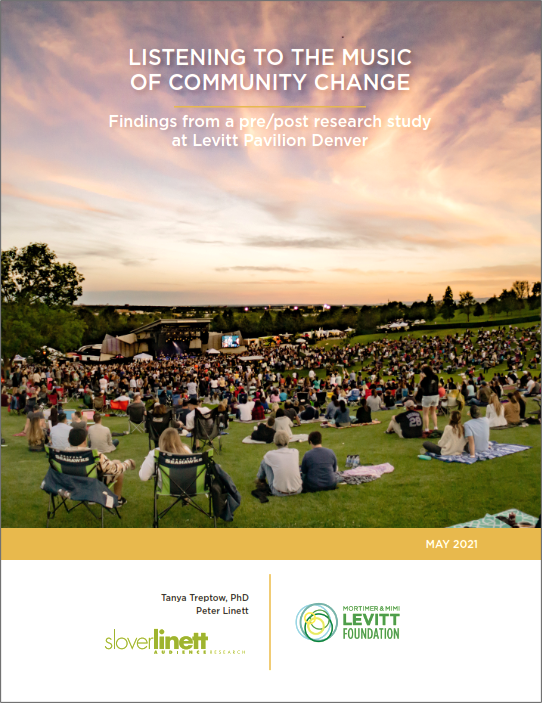News & Notes
Listening to the Music of Community Change: Announcing findings from a pre/post research study at Levitt Pavilion Denver
What’s the role of creative placemaking in communities experiencing change?
We’re excited to share a new white paper commissioned by the Levitt Foundation and several years in the making: Listening to the Music of Community Change—Findings from a Pre/Post Research Study at Levitt Pavilion Denver. The research examines how a new outdoor music venue has shifted perceptions and experiences of a Southwest Denver neighborhood and park over time, before and after the construction of the free music venue.
The study focused on Denver’s Ruby Hill, a largely residential and Hispanic/Latinx community, and used a range of qualitative research methods to explore shifting perspectives on Ruby Hill Park, the local neighborhood, and Levitt Pavilion Denver and its free summer concerts. Based on the lived experiences of local residents, park users, and other stakeholders, the new white paper examines how community identity is shaped by shared, informal arts experiences; how shifts in collective memory can influence residents’ attitudes toward the original arts investment; and how equitable practices can further a sense of belonging while fostering long-term investment in the community.
Part case study, part urban sociology, and part outcomes research, this report summarizes the third and final phase of a broader research initiative commissioned by the Mortimer & Mimi Levitt Foundation starting in 2013. The first two phases were published in a 2016 white paper, Setting the Stage for Community Change: Reflecting on Creative Placemaking Outcomes, which explored how the experience of free concerts at Levitt venues in Memphis and Pasadena, California fosters social interactions within groups and across demographic boundaries, thereby contributing to social capital and overall community vitality.
For the Denver pre/post study, Slover Linett looked at the unique “situatedness” of Levitt Pavilion Denver in multiple levels and definitions of “community.” The research aimed to understand the systemic dynamics of both equity and inequity in the local community, and to reveal residents’ perceptions and ideas about how the venue has played — or could play — a role in improving those dynamics.
It’s been a great pleasure and learning experience for us to work on these unique creative placemaking studies with the Levitt Foundation, especially executive director Sharon Yazowski and deputy director Vanessa Silberman. As Sharon put it in the official media release announcing the new white paper:
“As we reflect upon a year of tremendous challenges, loss and hardship, when many of our country’s inequities were laid bare, the role of the arts in fostering community and a sense of belonging has taken on even greater importance. This research has already informed our work, as we hope it will inspire others, to broaden inclusionary practices and support creative placemaking in communities undergoing change, with equity at the forefront.”
Our own Tanya Treptow, PhD, who directed the Denver “post” phase of the study, added: “This has been a rich conversation with many voices, including longtime local residents and more recent arrivals. By exploring these multi-layered, intersecting perspectives, we hope that this case study honors the complexity of communities and uncovers insights that can be useful to a wide range of practitioners and funders of creative placemaking and equitable arts-and-community-development projects.”
Please visit our Insights page to read or download the full white paper, executive summary, information sheet, and the press release. And as always, we’d love to hear your comments, questions, comparisons, etc. Please email Tanya Treptow here.

